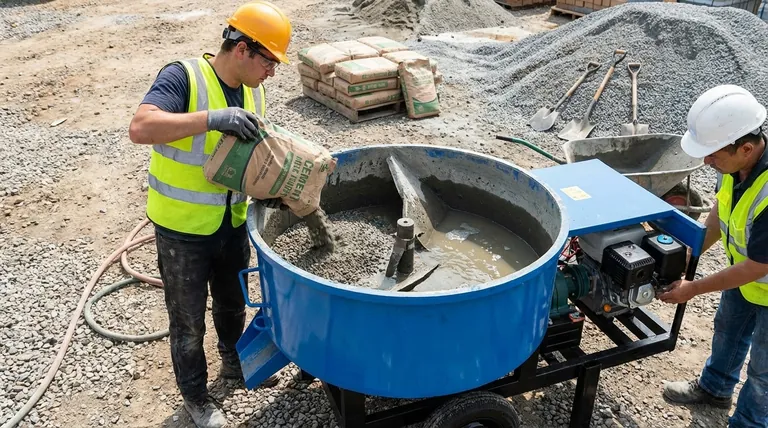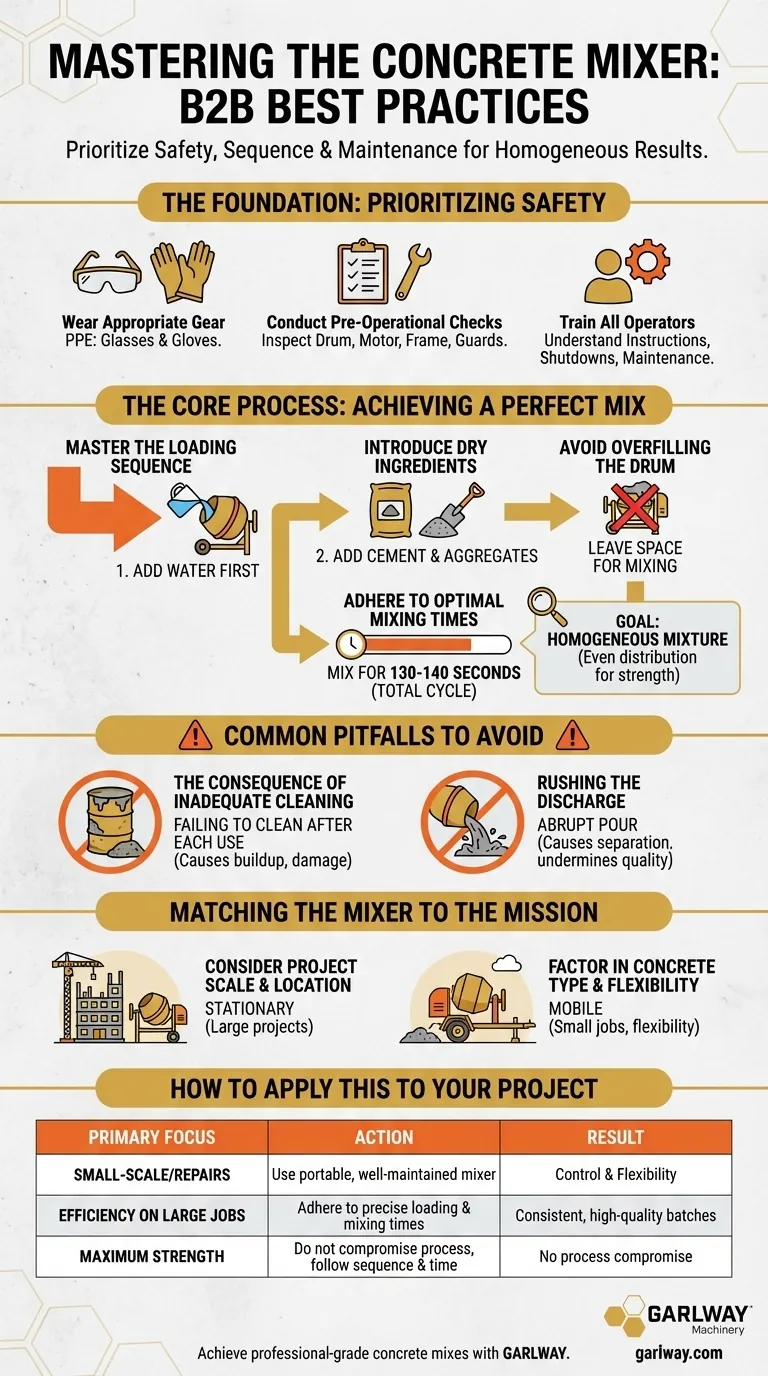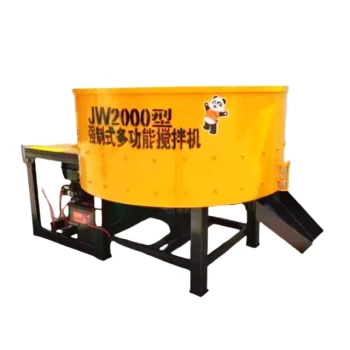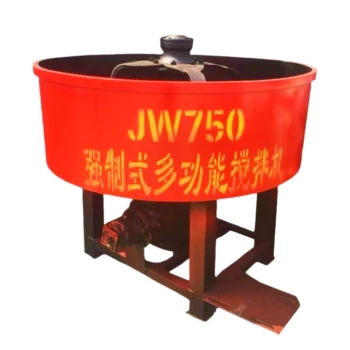To properly use a concrete mixer, you must prioritize safety, add materials in the correct sequence, and maintain the equipment meticulously. Always begin by adding the water, followed by the dry ingredients like aggregate and cement, and never overfill the drum. Thoroughly cleaning the mixer after every use is non-negotiable to prevent hardened buildup and ensure its longevity.
The goal of a concrete mixer isn't just to stir ingredients; it's to achieve a perfectly homogeneous mixture. Every tip, from loading order to mixing time, is designed to ensure the aggregates, cement, and water are evenly distributed for maximum strength and consistency.

The Foundation: Prioritizing Safety
Before you even think about the mix, you must establish a safe operating environment. This protects both the operator and the integrity of the project.
Wear Appropriate Gear
Always wear the correct personal protective equipment (PPE). This includes safety glasses to protect from splashes and dust, and heavy-duty gloves to prevent skin irritation or chemical burns from wet cement.
Conduct Pre-Operational Checks
Routinely inspect the mixer before use. Check for any damage to the drum, motor, or frame, and ensure all guards are securely in place. A well-maintained machine is a safer machine.
Train All Operators
Ensure anyone using the mixer understands the manufacturer's specific instructions. Proper training covers safe operation, emergency shutdown procedures, and routine maintenance checks.
The Core Process: Achieving a Perfect Mix
The quality of your concrete is directly determined by the precision of your mixing process. Following a consistent procedure is key to achieving strength and workability.
Master the Loading Sequence
The correct order of materials is critical. Begin by adding the specified amount of water to the drum. Then, introduce the dry ingredients, such as cement and aggregates. This method prevents dry material from clumping and sticking to the drum's interior.
Avoid Overfilling the Drum
Never fill the mixer to its maximum capacity. Leaving adequate space allows the internal blades to efficiently lift and tumble the materials, which is essential for properly coating the coarse aggregates with cement paste. An overfilled drum leads to a poor, inconsistent mix and increases the risk of spills.
Adhere to Optimal Mixing Times
Time is a critical factor in mix quality. The initial introduction of all materials should happen quickly, often within the first 20 seconds. The complete mixing cycle, however, typically requires around 130-140 seconds to achieve full homogeneity. Rushing this step will compromise the concrete's final strength.
Common Pitfalls to Avoid
Efficiency with a concrete mixer comes from avoiding common mistakes that can degrade your final product or damage your equipment over time.
The Consequence of Inadequate Cleaning
The single most common pitfall is failing to clean the mixer thoroughly after each use. Even a small amount of leftover concrete will harden, creating rough surfaces that trap more material in subsequent uses. This buildup reduces mixing efficiency and can eventually damage the drum and blades.
Rushing the Discharge
Just as mixing time is important, so is the discharge. Pour the mixed concrete smoothly from the tilting drum. An abrupt or poorly controlled pour can cause the aggregates and cement paste to separate, undermining the quality of your mix at the final stage.
Matching the Mixer to the Mission
Using a mixer effectively also means ensuring you have the right type of mixer for your specific project requirements.
Consider Project Scale and Location
For substantial construction projects, larger, stationary mixers are standard. For smaller jobs or sites with limited access, a mobile concrete mixer provides immense flexibility, allowing you to mix on-demand exactly where the concrete is needed.
Factor in Concrete Type
Different concrete mixes have different requirements. The inclined drum and blade design of a typical mixer is ideal for mixes with coarse aggregates. Always ensure your equipment is suited to the specific type of concrete your project demands.
How to Apply This to Your Project
- If your primary focus is small-scale projects or repairs: A portable, well-maintained mixer is your best asset, as it offers control and flexibility.
- If your primary focus is efficiency on a larger job site: Adhering to precise loading and mixing times is critical to producing consistent, high-quality batches quickly.
- If your primary focus is maximum concrete strength: Do not compromise on the process—follow the correct loading sequence and never shorten the mixing time.
Ultimately, treating your concrete mixer as a precision tool, rather than just a simple machine, is the key to achieving professional results.
Summary Table:
| Key Area | Essential Tip | Why It Matters |
|---|---|---|
| Safety | Wear PPE, conduct pre-use checks, train operators. | Prevents injury and ensures safe operation. |
| Mixing Process | Add water first, then dry ingredients; mix for 130-140 seconds. | Achieves a homogeneous mix for maximum strength. |
| Common Pitfalls | Never overfill the drum; clean thoroughly after every use. | Prevents inconsistent mixes and equipment damage. |
| Equipment Choice | Select a mixer (stationary or mobile) based on project scale. | Ensures efficiency and suitability for the job. |
Achieve professional-grade concrete mixes with GARLWAY.
As a specialist in construction machinery, GARLWAY provides durable and efficient concrete mixers, winches, and batching plants designed for the demands of construction companies and contractors worldwide. Our equipment helps you follow best practices effortlessly, ensuring safety, mix quality, and project efficiency.
Ready to enhance your concrete operations? Contact GARLWAY today to find the perfect mixer for your project's scale and requirements.
Visual Guide

Related Products
- Ready Mixer Machine for Construction Ready Mix Machinery
- Commercial Construction Mixer Machine for Soil Cement Mixing Concrete
- Auto Concrete Cement Mixer Machine New
- JDC350 Small Cement Concrete Mortar Mixer
- HZS90 Large Multiquip Concrete Mixers for Construction
People Also Ask
- Why is the manufacturer's strength and service important when choosing a concrete mixer? Ensure Long-Term Project Success
- What should be considered regarding the output of a concrete mixer? Match Capacity to Your Project Scale
- What was significant about Roscoe Lee's 1934 concrete mixer design? Pioneering Modular Construction Equipment
- When was the first concrete mixer developed and by whom? Discover the 1900 Breakthrough
- What is the function of a concrete mixer machine? Achieve Consistent, High-Quality Concrete for Your Projects



















